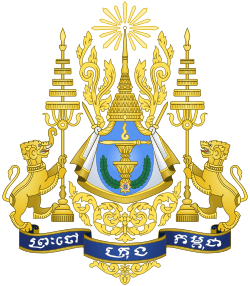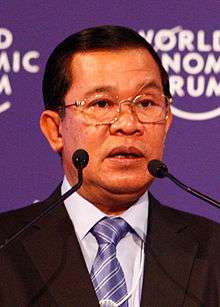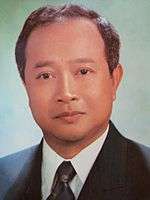Cambodian general election, 2003
| | |||||||||||||||||||||||||||||||||||||||||||||||||||||||||||||||||||||||
| |||||||||||||||||||||||||||||||||||||||||||||||||||||||||||||||||||||||
| |||||||||||||||||||||||||||||||||||||||||||||||||||||||||||||||||||||||
|
| |||||||||||||||||||||||||||||||||||||||||||||||||||||||||||||||||||||||
| Colours denote the winning party, as shown in the main table of results. | |||||||||||||||||||||||||||||||||||||||||||||||||||||||||||||||||||||||
| |||||||||||||||||||||||||||||||||||||||||||||||||||||||||||||||||||||||
 |
| This article is part of a series on the politics and government of Cambodia |
|
Monarchy |
|
| Foreign relations |
General elections were held in Cambodia on 27 July 2003 to elect members of the National Assembly. The election was won by the incumbent Prime Minister Hun Sen's Cambodian People's Party, who claimed a majority of 73 seats in the 123-seat parliament. However, due to the requirement for a two-thirds majority to elect a Prime Minister, a new government was not formed until July 2004 when a deal was reached with the Funcinpec party.
Background
Cambodia became a democracy in the early 1990s with the first democratic election held in 1993.[1] After both elections during the 1990s the Cambodian People's Party formed coalition governments with the royalist Funcinpec party.[1] The last election in 1998 saw significant amounts of violence and intimidation of opposition supporters.[2] It took place a year after Funcinpec had been violently ousted from the coalition government by the Cambodian People's Party.[3] However following the election they once more formed a coalition with Hun Sen as Prime Minister and Funcinpec's leader Prince Norodom Ranarridh, the son of King Norodom Sihanouk, as his deputy.[1]
In local elections in 2002 the Cambodian People's Party performed strongly leading in 1,597 of the 1,621 communes of Cambodia.[4] Meanwhile, the Funcinpec party suffered a setback dropping to only 22% of the vote.[4]
Campaign
The run-up to the election saw some violence including the killing of a judge and a royalist politician,[5] however it was much reduced from previous elections.[6] During the campaign the United States Secretary of State Colin Powell visited Cambodia, met all three main party leaders and called on all parties to have fair coverage in the media.[1] The opposition were able to get some time on television during the campaign,[4] but there were many reports in rural areas of voters being intimidated by the Cambodian People's Party.[7] In total 22 parties contested the election but only three were seen as real contenders in the election.[8]
The Cambodian People's Party had control of much of the media in Cambodia, the most money and a superior party machine.[2] The party campaigned on the economic development they said that they were bringing to Camdodia and in the March before the election they announced a 1.5 billion dollar program to counter poverty.[2] The party and their leader Hun Sen won support from voters due to their presiding over the most peaceful period in the countries recent history after ending the rule of the Khmer Rouge.[4] The party had the strongest support in rural areas of Cambodia, but younger voters in urban areas were more desirous of change and therefore supportive of the opposition.[9]
The two main opposition parties criticised the government of Hun Sen for its corruption and pledged to improve health and education in Cambodia.[8] Funcinpec called for reform of the economy and for more foreign investment, but their leader, Norodom Ranariddh, was seen as being ineffective and his party's popularity was in decline.[2][8] Meanwhile, the Sam Rainsy Party criticised corruption, pledged more money for health, education and civil servant pay and attempted to attract the poor.[8] The party had grown in strength since the previous election but their leader Sam Rainsy was seen as being authoritarian.[2]
Results

Voter turnout in the election was high with over 80% casting ballots.[10] The results saw the Cambodian People's Party win a clear majority of seats but fell short of the two-thirds majority required in order to elect a Prime Minister on their own.[11] Funcinpec lost ground dropping from the 31% they had won in 1998 to only just over 20% this time, while the Sam Rainsy Party rose to 22% from 14% in 1998.[12]
| Party | Votes | % | Seats | ||
|---|---|---|---|---|---|
| Cambodian People's Party | 2,447,259 | 47.3% | 73 | ||
| Sam Rainsy Party | 1,130,423 | 21.9% | 24 | ||
| FUNCINPEC | 1,072,313 | 20.8% | 26 | ||
| Khmer Democratic Party | 95,927 | 1.9% | — | ||
| The Rice Party | 76,086 | 1.5% | — | ||
| Indra Buddra Party | 62,338 | 1.2% | — | ||
| Proloung Khmer Party | 56,010 | 1.1% | — | ||
| Total (turnout 81.5%) | 5,168,837 | 123 | |||
| Sources:www.necelect.org.kh | |||||
Elected Members of Parliament
| Province | Representative | Party |
|---|---|---|
| Banteay Meanchey Province | Yim Chhaily | Cambodian People's Party |
| Banteay Meanchey Province | Vong Kan | Cambodian People's Party |
| Banteay Meanchey Province | Pal Sam Oeun | Cambodian People's Party |
| Banteay Meanchey Province | Try Chheang Huot | Cambodian People's Party |
| Banteay Meanchey Province | Kimsour Phirith | Sam Rainsy Party |
| Banteay Meanchey Province | Nheb Bunchin | Funcinpec |
| Battambang Province | Sar Kheng | Cambodian People's Party |
| Battambang Province | Nim Thot | Cambodian People's Party |
| Battambang Province | Ngin Khorn | Cambodian People's Party |
| Battambang Province | Ly Kim Leang | Cambodian People's Party |
| Battambang Province | Dul Koeun | Cambodian People's Party |
| Battambang Province | Eng Chhai Eang | Sam Rainsy Party |
| Battambang Province | Toan Vanthara | Sam Rainsy Party |
| Battambang Province | Nhek Bunchhai | Funcinpec |
| Kampong Cham Province | Heng Samrin | Cambodian People's Party |
| Kampong Cham Province | Math Ly | Cambodian People's Party |
| Kampong Cham Province | Hor Nam Hong | Cambodian People's Party |
| Kampong Cham Province | Chhor Leang Huot | Cambodian People's Party |
| Kampong Cham Province | Khiev Kanharith | Cambodian People's Party |
| Kampong Cham Province | Im Sothy | Cambodian People's Party |
| Kampong Cham Province | Yos Son | Cambodian People's Party |
| Kampong Cham Province | Ith Prang | Cambodian People's Party |
| Kampong Cham Province | N. Ranariddh | Funcinpec |
| Kampong Cham Province | You Hokry | Funcinpec |
| Kampong Cham Province | Chhim Siek Leng | Funcinpec |
| Kampong Cham Province | Kong Vibol | Funcinpec |
| Kampong Cham Province | Monh Saphan | Funcinpec |
| Kampong Cham Province | Sam Rainsy | Sam Rainsy Party |
| Kampong Cham Province | Mao Monyvann | Sam Rainsy Party |
| Kampong Cham Province | Thak Lany | Sam Rainsy Party |
| Kampong Cham Province | Cheam Channy | Sam Rainsy Party |
| Kampong Cham Province | Amath Yashya | Sam Rainsy Party |
| Kampong Chhnang Province | Kong Sam Ol | Cambodian People's Party |
| Kampong Chhnang Province | Uk Rabun | Cambodian People's Party |
| Kampong Chhnang Province | Tram Iv Teuk | Cambodian People's Party |
| Kampong Chhnang Province | Sok San | Funcinpec |
| Kampong Speu Province | Say Chhum | Cambodian People's Party |
| Kampong Speu Province | Hem Khorn | Cambodian People's Party |
| Kampong Speu Province | Ly Son | Cambodian People's Party |
| Kampong Speu Province | Samrith Pech | Cambodian People's Party |
| Kampong Speu Province | Nuth Rumdoul | Sam Rainsy Party |
| Kampong Speu Province | Leu Laysreng | Funcinpec |
| Kampong Thom Province | Nguon Nhel | Cambodian People's Party |
| Kampong Thom Province | Un Neung | Cambodian People's Party |
| Kampong Thom Province | Thong Khon | Cambodian People's Party |
| Kampong Thom Province | Poa Try | Cambodian People's Party |
| Kampong Thom Province | Sok Pheng | Sam Rainsy Party |
| Kampong Thom Province | Poa Bun Sreu | Funcinpec |
| Kampot Province | Ney Pena | Cambodian People's Party |
| Kampot Province | Chay Saing Yun | Cambodian People's Party |
| Kampot Province | Som Kimsuor | Cambodian People's Party |
| Kampot Province | Than Sina | Funcinpec |
| Kampot Province | Mam Bun Neang | Funcinpec |
| Kampot Province | Kieng Vang | Sam Rainsy Party |
| Kandal Province | Hun Sen | Cambodian People's Party |
| Kandal Province | Tep Ngorn | Cambodian People's Party |
| Kandal Province | Chhay Than | Cambodian People's Party |
| Kandal Province | Mom Chim Huy | Cambodian People's Party |
| Kandal Province | Ho Non | Cambodian People's Party |
| Kandal Province | Chan Cheng | Sam Rainsy Party |
| Kandal Province | Chrea Sochenda | Sam Rainsy Party |
| Kandal Province | Ngor Sovann | Sam Rainsy Party |
| Kandal Province | N. Sereyvouth | Funcinpec |
| Kandal Province | Hong Sun Huot | Funcinpec |
| Kandal Province | Sun Chan Thol | Funcinpec |
| Koh Kong Province | Ay Khorn | Cambodian People's Party |
| Kratie Province | Im Chhun Lim | Cambodian People's Party |
| Kratie Province | Chhan Saphan | Cambodian People's Party |
| Kratie Province | Princess N. Ratanatevy | Funcinpec |
| Mondulkiri Province | Rath Sarem | Cambodian People's Party |
| Phnom Penh Municipality | Choulong Somora | Sam Rainsy Party |
| Phnom Penh Municipality | Yim Sovann | Sam Rainsy Party |
| Phnom Penh Municipality | Son Chhay | Sam Rainsy Party |
| Phnom Penh Municipality | Keo Remy | Sam Rainsy Party |
| Phnom Penh Municipality | Ho Vann | Sam Rainsy Party |
| Phnom Penh Municipality | Sok Soty | Sam Rainsy Party |
| Phnom Penh Municipality | Chea Sim | Cambodian People's Party |
| Phnom Penh Municipality | Sim Ka | Cambodian People's Party |
| Phnom Penh Municipality | Keat Chhon | Cambodian People's Party |
| Phnom Penh Municipality | Um Nhanh | Cambodian People's Party |
| Phnom Penh Municipality | N. Vichora | Funcinpec |
| Phnom Penh Municipality | Khy Taing Lim | Funcinpec |
| Preah Vihear Province | Suk Sam Eng | Cambodian People's Party |
| Prey Veng Province | Chea Soth | Cambodian People's Party |
| Prey Veng Province | Nhim Vanda | Cambodian People's Party |
| Prey Veng Province | Cheam Yeab | Cambodian People's Party |
| Prey Veng Province | Ek Sam Ol | Cambodian People's Party |
| Prey Veng Province | Pen Panha | Cambodian People's Party |
| Prey Veng Province | Min Sean | Cambodian People's Party |
| Prey Veng Province | Veng Sereyvuth | Funcinpec |
| Prey Veng Province | Kuoch Ky | Funcinpec |
| Prey Veng Province | Princess Sisowath Santha | Funcinpec |
| Prey Veng Province | Chea Poch | Sam Rainsy Party |
| Prey Veng Province | Khim Veasna | Sam Rainsy Party |
| Pursat Province | Suy Sem | Cambodian People's Party |
| Pursat Province | Chin Bun Sean | Cambodian People's Party |
| Pursat Province | Mey Norn | Cambodian People's Party |
| Pursat Province | Ly Thuch | Funcinpec |
| Ratanakiri Province | Bou Thang | Cambodian People's Party |
| Siem Reap Province | Tea Banh | Cambodian People's Party |
| Siem Reap Province | Cham Prasith | Cambodian People's Party |
| Siem Reap Province | Sieng Nam | Cambodian People's Party |
| Siem Reap Province | Keo Saphal | Cambodian People's Party |
| Siem Reap Province | Pou Sohtireak | Funcinpec |
| Siem Reap Province | Ker Sonarorth | Sam Rainsy Party |
| Sihanoukville Municipality | Suos Kanan | Cambodian People's Party |
| Stung Treng Province | Sorn Inthor | Cambodian People's Party |
| Svay Rieng Province | Men Sam Orn | Cambodian People's Party |
| Svay Rieng Province | Him Chhem | Cambodian People's Party |
| Svay Rieng Province | Hul Savorn | Cambodian People's Party |
| Svay Rieng Province | Duong Vanna | Cambodian People's Party |
| Svay Rieng Province | Khun Haing | Funcinpec |
| Takeo Province | Sok An | Cambodian People's Party |
| Takeo Province | So Khun | Cambodian People's Party |
| Takeo Province | Mok Mareth | Cambodian People's Party |
| Takeo Province | Chan Sarun | Cambodian People's Party |
| Takeo Province | Nin Saphon | Cambodian People's Party |
| Takeo Province | Keo Saphal | Funcinpec |
| Takeo Province | Khek Vandy | Funcinpec |
| Takeo Province | Kuoy Bun Reun | Sam Rainsy Party |
| Keb Municipality | Kea Sahorn | Cambodian People's Party |
| Pailin Municipality | Y Chhean | Cambodian People's Party |
| Uddar Meanchey Province | Nou Sam | Cambodian People's Party |
Source: "Election results". Cambodia National Election Committee. Accessed June 18, 2008.
Aftermath
Following the election Funcinpec and the Sam Rainsy Party refused to attend parliament and formed an "Alliance of Democrats" in order to block Hun Sen from being elected Prime Minister again.[13] They rejected the official results and said that they had been manipulated by the Cambodian People's Party.[11] After initially boycotting parliament the two parties were persuaded by the King to attend the swearing in at the end of September, but remained firm in rejecting joining a government led by Hun Sen.[14] However, despite no government being formed, a caretaker administration run by Hun Sen and the Cambodian People's Party was able to continue.[14]
A provisional agreement was said to have been reached in November on a three party government led by Hun Sen but the opposition later denied this.[13] Personal dislike between the three parties and the opposition of the Cambodia People's Party to a three party government meant negotiations on forming a government dragged on into 2004.[13] Eventually, 11 months after the election,[15] towards the end of June 2004 the Cambodia People's Party and Funcinpec reached an agreement under which ministerial seats would be divided up 60-40 between them and Hun Sen would remain Prime Minister.[16] On the 15 July 2004 the Cambodian parliament finally approved the new government with 96 of the 123 members voting in favour.[17] There was a significant increase in the number of ministers to 207, including 7 deputy prime ministers and 180 cabinet ministers, in order to reach agreement on the new government.[15]
Literature
- Sorpong Peou (2006), "Consolidation or Crisis of Democracy?: Cambodia's Parliamentary Elections in 2003 and Beyond", Between Consolidation and Crisis: Elections and Democracy in Five Nations in Southeast Asia, Berlin: Lit, pp. 41–83
References
- 1 2 3 4 Kazmin, Amy (2003-06-20). "Powell call over Cambodian poll media US OFFICIAL'S VISIT:". Financial Times. p. 10.
- 1 2 3 4 5 "Asia: Limousines and poverty; Cambodia". The Economist. 2003-06-07. p. 62.
- ↑ Spillius, Alex (2003-07-28). "Hun Sen on his way to poll win in Cambodia". The Daily Telegraph. p. 12.
- 1 2 3 4 "Asia: Stronger and stronger; Cambodia's election". The Economist. 2003-07-26. p. 59.
- ↑ Madra, Ek (2003-04-24). "Senior Cambodian judge assassinated". The Independent. p. 16.
- ↑ Aglionby, John (2003-07-26). "Cambodia edges towards change". The Guardian. p. 17.
- ↑ Kazmin, Amy (2003-07-26). "Dark threats likely to keep Cambodia's ruling party in power". Financial Times. p. 5.
- 1 2 3 4 "Cambodia Election Guide". BBC Online. 2003-07-25. Retrieved 2009-05-27.
- ↑ Kazmin, Amy (2003-07-22). "Cambodia's disenchanted young grow restless for a brighter future: Many are fervently hoping for a new government when this Sunday the country goes to its first poll since 1998, Amy Kazmin reports". Financial Times. p. 9.
- ↑ Aglionby, John (2003-07-28). "80% turnout for Cambodian vote". The Guardian. p. 10.
- 1 2 Kazmin, Amy (2003-07-30). "Opposition rejects Hun Sen victory claim CAMBODIAN ELECTIONS:". Financial Times. p. 9.
- ↑ Kazmin, Amy (2003-07-31). "Cambodian prime minister rejects calls to step down". Financial Times. p. 9.
- 1 2 3 "Asia: Deadlock; Cambodia;". The Economist. 2004-02-21. p. 66.
- 1 2 Kazmin, Amy (2003-09-29). "Cambodian parties boycott parliament over resignation call". Financial Times. p. 2.
- 1 2 "Cambodian government faces uphill task". BBC Online. 2004-07-15. Retrieved 2009-05-27.
- ↑ Kazmin, Amy (2004-06-28). "Coalition deal in Cambodia ends 11-month post-election standoff". Financial Times. p. 2.
- ↑ "Cambodian parliament ends deadlock". BBC Online. 2004-07-15. Retrieved 2009-05-26.



